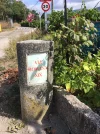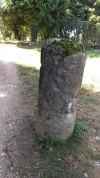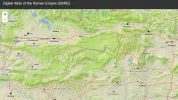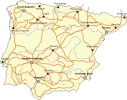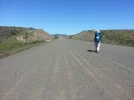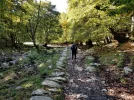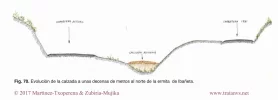I wasn’t thinking of infrastructure or the imprints of culture etc, but of the “stones and bones” features of the actual road itself. Tarmac is one obvious change, but I wonder if 1000 years ago more sections of the engineered stone roads were visible, obviously less eroded, or pretty much as they are now?
Not sure I was clear enough -- but Roman roads were dirt roads along most of their length, so that when I say that the current dirt roads are similar but the tarmacked sections are not, it was an answer.
As to the paved section, virtually nothing remains of them, though some cobbled sections where the cobbles were maintained well into the Middle Ages (
very locally, that's an exception to the general situation) do remain, though it's doubtful if it's in the original Roman configuration.
Some old roman roads, since tarmacked, that approach old towns do have the hump typical of those roads, but again these are just rare structural and infrastructural remnants.
And roads themselves are by their very nature infrastructures.
But when we encounter the stone roads that still sit at the surface, and we can see the cart ruts in the stones... well how much more shallow were they (if at all) 100 years ago? Were the stone sections significantly longer than they are now, or pretty much the same?
Well, one does have to remember that some of those paved/flagged roads that persist are Mediaeval or Renaissance, rather than Roman.
Many "Roman" roads or paths or ways in Europe are actually nothing of the sort -- there are four or five of them just locally ; but only one of them is the remnant, along mostly a different track than the original, of the Via Aurelia.
The others are pathways down from the mountains to the market town, and could be pre-roman, roman, mediaeval, or even early modern -- although the village uphill was the frontier between Cisalpine and Transalpine Gaul, and was an important hub for the road system, and has the remains of a major Roman Trophy monument.
I think of the Roman foundations below the approach to Notre Dame Church in Paris, for example.
The Roman city was mostly south of the river, in the accidentally well-named Latin Quarter -- named because the mediaeval scholars, Doctors, and theologians spoke Latin, not for the Roman origins of the
quartier around the Sorbonne.
They established themselves there as Julius Caesar had demonstrated massive flaws in the defences of the two Parisian islands, that would only be corrected in the Middle Ages and by the mediaeval defensive ramparts architecture and the canalisation work on the river itself.






